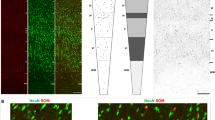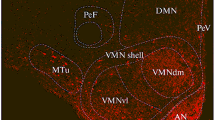Summary
The caudal extension of the hypothalamic A13 dopamine cell group (A13c) was studied in the rat brain with immunohistochemical techniques using antibodies raised against the dopamine synthesizing enzymes tyrosine hydroxylase (TH) and aromatic L-amino acid decarboxylase (AADC). Adjacent sections revealed that the TH- and AADC-staining patterns exhibited a clear overlap with that for somatostatin (SOM). Employing a double-labelling method with SOM- and AADC-antisera and subsequent elution and restaining of the same section with TH-antiserum, it was found that all immunoreactivities occurred in the same cell bodies. This study gives the first evidence for the presence of SOM-immunoreactivity in dopamine neurons.
Similar content being viewed by others
References
Blessing WW, Howe PRC, Joh TH, Oliver JR, Willoughby JO (1986) Distribution of tyrosine hydroxylase and neuropeptide Y-like immunoreactive neurons in rabbit medulla oblongata, with attention to colocalization studies, presumptive adrenaline-synthesizing perikarya, and vagal preganglionic cells. J Comp Neurol 248: 285–300
Buchan AMJ, Sikora LKJ, Levy JG, McIntosh CHS, Dyck I, Brown JC (1985) An immunocytochemical investigation with monoclonal antibodies to somatostatin. Histochemistry 83: 175–180
Chan-Palay V, Záborszky L, Köhler C, Goldstein M, Palay SL (1984) Distribution of tyrosine-hydroxylase-immunoreactive neurons in the hypothalamus of rats. J Comp Neurol 227: 467–496
Dahlström A, Fuxe K (1964) Evidence for the existence of monoamine-containing neurons in the central nervous system. I. Demonstration of monoamines in the cell bodies of brain stem neurons. Acta Physiol Scand 62, Suppl232: 1–55
Everitt BJ, Hökfelt T, Terenius L, Tatemoto K, Mutt V, Goldstein M (1984) Differential co-existence of neuropeptide Y (NPY)-like immunoreactivity with catecholamines in the central system of the rat. Neuroscience 11: 443–462
Everitt BJ, Meister B, Hökfelt T, Melander T, Terenius T, Rökaeus Å, Theodorsson-Norheim E, Dockray G, Edwardson J, Cuello C, Elde R, Goldstein M, Hemmings H, Ouimet C, Walaas I, Greengard P, Vale W, Weber E, Wu J-Y, Chang K-J (1986) The hypothalamic arcuate nucleus-median eminence complex: immunohistochemistry of transmitters, peptides and DARPP-32 with special reference to coexistence in dopamine neurons. Brain Res Rev 11: 97–155
Hökfelt T, Elfvin L-G, Elde R, Schultzberg M, Goldstein M, Luft R (1977) Occurrence of somatostatin-like immunoreactivity in some peripheral sympathetic noradrenergic neurons. Proc Natl Acad Sci 74: 3587–3591
Hökfelt T, Skirboll L, Rehfeld JF, Goldstein M, Markey K, Dann O (1980) A subpopulation of mesencephalic dopamine neurons projecting to limbic areas contains a cholecystokininlike peptide: evidence from immunohistochemistry combined with retrograde tracing. Neuroscience 5: 2093–2124
Hökfelt T, Everitt BJ, Theodorsson-Norheim E, Goldstein M (1984a) Occurrence of neurotensinlike immunoreactivity in subpopulations of hypothalamic, mesencephalic, and medullary catecholamine neurons. J Comp Neurol 222: 543–559
Hökfelt T, Mårtensson R, Björklund A, Kleinau S, Goldstein M (1984b) Distribution maps of tyrosine-hydroxylase-immunoreactive neurons in the rat brain. In: Björklund A, Hökfelt T (eds) Handbook of chemical neuroanatomy, Vol 2. Classical transmitters in the CNS, Part I. Elsevier Science Publishers, Amsterdam, pp 277–379
Jaeger CB, Ruggiero DA, Albert VR, Park DH, Joh TH, Reis DJ (1984) Aromatic L-amino acid decarboxylase in the rat brain: immunohistochemical localization in neurons of the brain stem. Neuroscience 11: 691–713
Joh TH, Ross ME (1983) Preparation of catecholamine synthesizing enzymes as immunogen for immune histochemistry. In: Cuello AC (ed) Immunohistochemistry, IBRO handbook series, Vol 3. J. Wiley, Chichester, pp 121–138
Johnson DG, de C Nogueira Araujo GM (1981) A simple method of reducing the fading of immunofluorescence during microscopy. J Immunol Methods 43: 349–350
Markey KA, Kondo S, Shenkman L, Goldstein M (1980) Purification and characterization of tyrosine hydroxylase from a clonal pheochromocytoma cell line. Mol Pharmacol 17: 79–85
Meister B, Hökfelt T, Vale W, Sawchenko PE, Swanson L, Goldstein M (1986) Coexistence of tyrosine hydroxylase and growth hormone-releasing factor in a subpopulation of tubero-infundibular neurons of the rat. Neuroendocrinology 42: 237–247
Paxinos G, Watson C (eds) (1986) The rat brain in stereotaxic coordinates, 2nd edn. Academic Press, Sydney
Sawchenko PE, Swanson L, Grzanna R, Howe PRC, Bloom SR, Polak JM (1985) Colocalization of neuropeptide Y immunoreactivity in brainstem catecholaminergic neurons that project to the paraventricular nucleus of the hypothalamus. J Comp Neurol 241: 138–153
Skagerberg G, Meister B, Hökfelt T, Lindvall O, Goldstein M, Joh T, Cuello AC (1987) Studies on dopamine-, tyrosine hydroxylase-and aromatic L-amino acid decarboxylase-containing cells in the rat diencephalon: comparison between formaldehyde-induced histofluorescence and immunofluorescence methods. Neuroscience (in press)
Tramu G, Pillez A, Leonardelli J (1978) An efficient method of antibody elution for the successful or simultanious location of two antigens by immunocytochemistry. J Histochem Cytochem 26: 322–324
van den Pol AN, Herbst RS, Powell JF (1984) Tyrosine hydroxylase-immunoreactive neurons of the hypothalamus: a light and electron microscopic study. Neuroscience 13: 1117–1156
Zamboni K, de Martino C (1967) Buffered acid formaldehyde: a new rapid fixative for electron microscopy. J Cell Biol 148A: 35
Author information
Authors and Affiliations
Rights and permissions
About this article
Cite this article
Meister, B., Hökfelt, T., Brown, J. et al. Dopaminergic cells in the caudal A13 cell group express somatostatin-like immunoreactivity. Exp Brain Res 67, 441–444 (1987). https://doi.org/10.1007/BF00248566
Received:
Accepted:
Issue Date:
DOI: https://doi.org/10.1007/BF00248566




